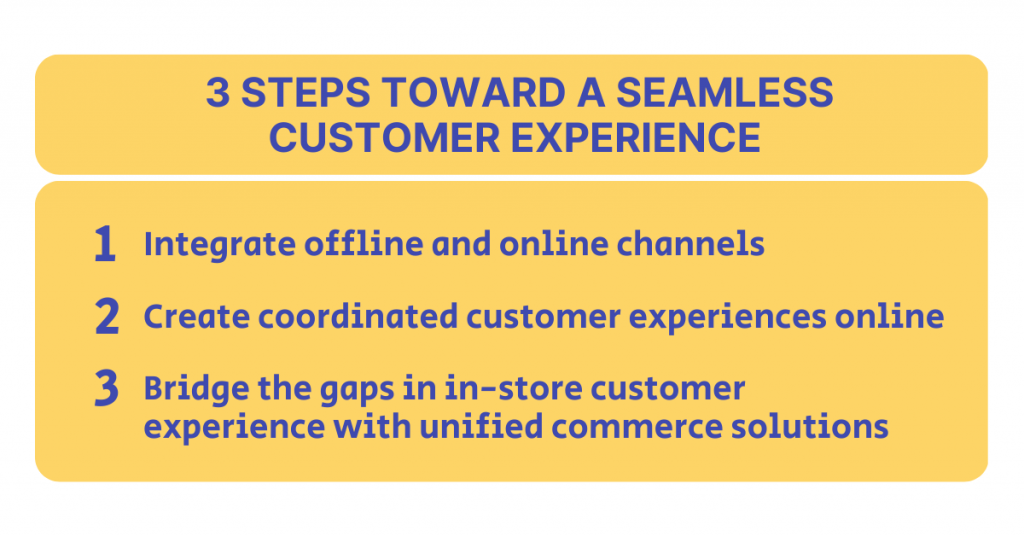This is the third installment of our Unified Commerce series, and we continue to explore the world of unified commerce and how Magento (Adobe Commerce) enables businesses in this realm. If you haven’t already, make sure to check out the second article in the series.
In today’s highly competitive retail environment, it’s essential for your business to integrate sales channels so you can offer a seamless and unified commerce experience to customers. Consumers are using multiple channels to shop, including brick-and-mortar stores, online marketplaces, social media, and mobile devices. Hence, businesses that only focus on one or two channels risk losing potential customers.
Integrating sales channels allows businesses to reach customers wherever they are, providing a consistent and personalized experience across all touchpoints. Additionally, a unified commerce strategy can streamline operations, reduce costs, and improve efficiency. In this blog post, we’ll explore how integrating sales channels with Magento (Adobe Commerce) can help your business achieve success with a unified commerce strategy and provide tips for successful implementation.
Understanding sales channels
Sales channels are the different avenues through which businesses sell their products or services. These channels can be physical or digital, and businesses use multiple channels to reach their target audience. Understanding the different types of sales channels and their benefits is crucial for developing a successful unified commerce strategy.
Sales channels can be divided into two broad categories: brick-and-mortar and online. Brick-and-mortar sales channels include physical stores, kiosks, pop-up shops, and other physical locations where customers can buy products or services. Online sales channels include eCommerce websites, mobile apps, social media platforms, marketplaces, and other digital platforms.

Types of sales channels
1. Brick-and-mortar stores
Physical stores remain an important sales channel for many businesses, despite the rise of eCommerce. These stores provide customers with hands-on experience with products and allow merchants to build personal relationships with their customers.
2. Online stores
Online stores have become massively popular in recent years, especially during the pandemic, allowing businesses to reach customers beyond their local area. eCommerce platforms like Magento (Adobe Commerce) provide merchants with powerful tools to create online stores that are customizable and easy to use.
3. Social media
Social media platforms like Facebook, Instagram, and Pinterest have also become some of the most important sales channels for brands. These platforms allow them to reach a large audience with targeted advertising and provide customers with an easy way to buy products.
4. Marketplaces
Online marketplaces like Amazon, eBay, and Etsy provide retailers with a platform where they can sell their products to a larger audience. These marketplaces have millions of active users and provide businesses with access to a large and engaged customer base.
Benefits of using multiple sales channels
Using multiple sales channels provides businesses with several benefits. By using different channels, merchants can reach customers where they are most comfortable shopping, providing a seamless and personalized experience. This can increase customer loyalty and drive sales. Additionally, using multiple sales channels can help businesses diversify their revenue streams and reduce their dependence on a single channel. This can improve the overall stability of the business and provide a hedge against economic uncertainty. By understanding the different types of sales channels and their benefits, businesses can create a unified commerce strategy that maximizes their reach and revenue potential.
Tips for integrating sales channels in a unified commerce strategy
1. Consolidate your inventory
To avoid overselling or underselling products, you should consolidate your inventory and keep it up to date in real time. This can be achieved by using a centralized inventory management system that syncs data across all sales channels.
2. Automate your processes
Automating processes can help you save time and reduce errors. Magento (Adobe Commerce) offers several automation tools, not to mention countless extensions available in the Magento Marketplace, to support processes such as order fulfillment, payment processing, and shipping. By automating these processes, you can reduce the time and resources needed to manage sales channels and free up staff to focus on other important tasks.
3. Keep your data in sync
Keeping data in sync across all sales channels is crucial for providing customers with a consistent and personalized experience. You should use a centralized data management system that syncs data across all sales channels in real time. This will ensure that inventory, pricing, and other data is accurate and up-to-date.
4. Customize your channels
Each sales channel has its own unique requirements and customer base. To maximize the potential of each sales channel, customize your channels to meet the needs of your target audience. This can include optimizing product listings, creating targeted advertising campaigns, and tailoring promotions to each channel.
5. Offer consistent customer service
Providing consistent customer service across all channels (phone, email, live chat, etc.) is crucial for maintaining customer loyalty and trust. Ensure that your customer service representatives are trained to handle inquiries and complaints across all sales channels.
6. Monitor and analyze your channels
To optimize sales channels and improve customer experience, you should monitor and analyze your sales channels regularly. This can include tracking sales data, analyzing customer behavior, and measuring the effectiveness of advertising campaigns. By collecting such data, you can identify areas for improvement and make data-driven decisions to optimize your sales channels.

Why integrate sales channels with Magento (Adobe Commerce)?
Magento (Adobe Commerce) is a powerful eCommerce platform that provides your business with the tools required to implement a unified commerce strategy. The platform offers a range of features and functionalities, including inventory management, order fulfillment, customer management, and marketing automation to enable unified commerce.
Magento (Adobe Commerce) offers several advantages for businesses, including:
- Customizability: Magento is highly customizable, allowing businesses to tailor their online store to meet their unique business needs and brand identity.
- Scalability: Magento is designed to scale with businesses as they grow, allowing them to easily add new products, services, and sales channels.
- Integration: Magento integrates with an extensive range of third-party tools and services that help make managing sales channels and streamlining business operations easier and more effective.
When you integrate all your sales channels with Magento (Adobe Commerce), it becomes much easier to connect with other integrations. Since everything flows through Magento, you can easily integrate with other third-party tools and services such as payment gateways, shipping providers, and marketing automation software. This can help you streamline your operations, reduce manual errors, and improve efficiency.
Furthermore, integrating your sales channels with Magento (Adobe Commerce) results in a single source of data. All data such as orders, loyalty points, sales, delivery, and inventory are consolidated in one place. This can provide you with a comprehensive view of all your operations, making it easy to manage your customers, accounting, purchasing, and marketing campaigns in one place. With all the data synchronized and updated in real time, you can make informed decisions and respond to changes quickly. It can also help you improve customer service by enabling you to provide customers with up-to-date information on orders, deliveries, and other important information.
Optimizing customer experience across online and offline channels with Magento (Adobe Commerce)

1. Integrating offline and online channels
Integrating offline channels with Magento (Adobe Commerce) can provide you with a better view of customer behaviors and preferences. This integration involves connecting the point-of-sale (POS) system to Magento and providing inventory visibility across offline and online channels. This can lead to customers enjoying more tailored and relevant shopping experiences both online and offline and your business gaining valuable customer insights that can be used to enhance targeting and increase engagement and loyalty.
2. Creating coordinated customer experiences
Achieving a successful unified commerce strategy requires you to enhance both the online and offline customer experience. This involves integrating online and offline channels to create a comprehensive view of the customer, personalizing mobile applications according to customer information and usage, and using sales and marketing tools such as promotional emails, abandoned cart notifications, and digital receipts. Moreover, you can leverage digital analytics tools to analyze customer behavior and preferences. These optimization practices enable coordinated marketing efforts across multiple touchpoints, resulting in a seamless and unified customer experience no matter which channel they engage with.
3. Bridging the gaps in in-store customer exprience with unified commerce solutions
To establish an enhanced unified commerce experience in physical stores, you should consider adding features such as click-and-collect, endless aisles, and hassle-free returns. Additionally, you can use a store assistant app and unified journey analytics to minimize the friction between customers and staff, resulting in a personalized and smooth experience. Such practices can lead to significant sales growth for your business while providing customers with positive experiences in-store.
Conclusion
In conclusion, in order to succeed in the current retail landscape, you need to integrate your sales channels and create a seamless and unified commerce experience for customers. By understanding the various sales channels, you can tailor your strategy to your target audience and provide a personalized experience across all touchpoints.
Integrating sales channels with Magento (Adobe Commerce) offers several advantages, including customizability, scalability, and integration with third-party tools and services. It also provides you with a single source of data and comprehensive visibility of your operations, allowing for informed decision-making and improved customer service.
To achieve a successful unified commerce strategy, you need to optimize both online and offline channels. Integrate online and offline channels to develop a single view of your customers, personalize mobile apps based on customer information, and leverage sales and marketing tools.
Ultimately, a successful unified commerce strategy can lead to increased customer loyalty, sales growth, and improved efficiency for your business. By implementing the tips and strategies outlined in this blog post, you can enhance your sales channels and provide a positive and consistent experience for customers, regardless of the channels they use.
Integrating your sales channels is a crucial part of a unified commerce strategy. Get in touch today and we’ll create a roadmap specific to your business needs. Our Growth Team will be happy to walk you through all the opportunities waiting for you in unified commerce.
The Unified Commerce series
- Part 1: Embracing Unified Commerce with Magento (Adobe Commerce)
- Part 2: Unified Commerce with Magento (Adobe Commerce): Best Practices and Case Studies
- Part 3: Integrating Your Sales Channels with Magento (Adobe Commerce)
- Part 4: Enabling Personalization in a Unified Commerce Strategy with Magento (Adobe Commerce)
- Part 5: Data Centralization: Unlocking Unified Commerce Success with Magento


Share on: